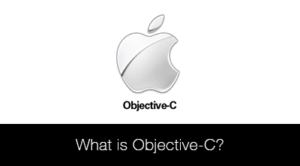What is Objective-C?
Objective-C is an object-oriented programming language that is used to derive OS X and iOS and their APIs.

Definition
Objective-C programming is a programming language that is used for general-purpose activities. While it is not specific to any particular platform or system, it can greatly aid in developing a variety of other frameworks. Objective-C programming adds messaging capabilities to the programming language C.
Objective-C is one of the main programming languages used by Apple for the iOS system and can be used to create mobile applications for this specific platform. As a superset of the C programming language, it offers the ability for developers to be more detail-oriented as well as more supportive of objects and other languages.
There are varied programming languages. At present, three programming languages are in great demand, i.e., Swift, Objective C, and C++. Let’s see some of the basic differences between Objective-C and the other 2 languages:
All the Details
Objective-C is great for memory management; there are compilers available that can convert Objective-C code into static code analysis, which the language will then use to sort useful information and “garbage” into two separate categories.
The most important thing about Objective-C to know is that it is heavily object-oriented. You can move graphs and manipulate files using this supplementary language, but it is important to understand its limitations just as much as it is important to understand its advantages.
As a language that was invented in the 1980s, Objective-C still has a great many features that are used in iOS-specific mobile app developments. While there hasn’t been an innovation that allows Objective-C to be used across all sorts of platforms, it is integrative for the use of C and other languages for iOS applications.
Objective-C is in competition with Swift, which is a newer iOS programming language. There are many debates between which programming language offers better results for iOS mobile app developments.
Difference between Objective-C and Swift:
Swift is the programming language that was first launched by Apple in June 2014. Objective-C yields all warts you’d expect from a language formed on C. To distinguish keywords and types from C types, Objective-C preceded new keywords applying the @ symbol. Because Swift isn’t made on C, it can ally all the keywords and extract the numerous @ symbols in the presence of every Objective-C type or object-related keyword.
Swift code almost mirrors natural English, in addition to other contemporary programming languages. This readability makes it simpler for existing programmers from JavaScript, Java, Python, C#, and C++ to embrace Swift into their toolchain—unlike the unpleasant experience that programmers had to face using Objective-C.
Difference between Objective-C and C++:
Introduced in 1979, Wilkerson says that C++ was explicitly designed to combine objects and instance methods to the original C language. This was based on the idea that object-oriented programming would be more productive and effective for large software projects—something that some senior experts mentions the reason for C++’s broad adoption in the years since. As per some experts of the programming community, C++ is the language used to write many current desktop applications, and as a result of this large user base—a wide number of frameworks and libraries have been created to elongate C++ for functions like high-performance graphics, audio digital signal processing, and user interface design.
Both the languages are rooted in C, but they are two completely different languages. A major variation is that Objective-C is directed on runtime-decisions for transmitting and profoundly depends on its runtime library to manage inheritance and polymorphism. At the same time, in C++ the locus usually lies on latent, compile-time, conclusions. C++ is a middle-level language that is being operated on different cross-platform operating systems such as Windows, UNIX, Macintosh OS, etc. In contrast, Objective C is general-purpose, and object-oriented programming language employed by Apple in its operating systems and APIs Cocoa etc.
Advantages & Disadvantages of Objective C:
Advantages:
- Interoperability with C++ and Objective C++
- Effective characteristics like method swizzling
- More reliable support for coding Binary Frameworks.
Disadvantages:
- Since Objective-C is formed on top of C, it needs namespacing. All classes in an Objective-C application should be unique worldwide. So to dodge contention, there is a practice of prefixing the names of classes. This is the purpose we own the ‘NS’ prefix for the class in the Foundation Framework and the ‘UI’ prefix for the classes in UIKit.
- Specific pointers.
- The capability to send a message on a nil object without dropping and the absence of strict typing lead to bugs that are difficult to track and fix.
- The language is syntactically tedious and complicated.
Things to Consider
Objective-C app development can be streamlined and can be a great way to add object-based features to your application. There are a few key points to keep in mind about this superset language:
- Maintenance is required – this refers to updating the apps that were developed using Objective-C. The language may be dated, but it is not obsolete. It just requires some work to keep it relevant.
- Not as much adaptation required – many APIs still have a lot of catching up to do for apps that are developed with Swift. This means that it may be easier to apply Objective-C to an iOS mobile application.
- Easier management of objects – Apple is all about having a network of objects. With Objective-C, these objects can be moved easily.
Objective-C can be used to streamline iOS mobile apps across all types of Apple iOS platforms, including phones and tablets.